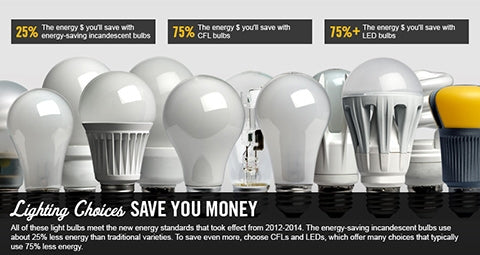
If you have been in the market for light bulbs lately, you’ve noticed some changes in how you shop for bulbs. Why? Federal regulations have phased out the “old-style” incandescent in lieu of energy-efficient, longer-lasting bulbs. This is great news for your pocketbook, but it also leads to confusion because the days of shopping for a light bulb based on wattage have drastically changed. The reason for that is that wattage tells how much energy a bulb uses. And since the new LED, halogen incandescent and CFL (Compact Fluorescent Lamp) bulbs use much less energy, their wattage is different. So now what?
When shopping for light bulbs, focus on the amount of lumens the light bulb offers. Lumens are the amount of light produced. More lumens equates to brighter light. While less lumens equates to a dimmer light.
Thanks to updated light bulb packaging, the lumens are clearly displayed to help you purchase the appropriate light for your application. Here are some guidelines for choosing bulbs that are equivalent in light output to the familiar standard incandescent bulbs (compliments of the American Lighting Association):
- To replace a 100-watt incandescent bulb, choose a bulb that gives you 1,600 lumens.
- To replace a 75-watt incandescent bulb, choose a bulb that gives you 1,100 lumens.
- To replace a 60-watt incandescent bulb, choose a bulb that gives you 800 lumens.
- To replace a 40-watt incandescent bulb, choose a bulb that gives you 450 lumens.

So what if you have a lower wattage bulb, like say a 10 watt halogen bulb and you want to upgrade to an LED light? You will obviously want to get a comparable lumen output, right? This is the situation that I am facing now. I have older halogen 10 watt accent lights located in the front of my house. I want to update to comparable-output LED lights.
After examining a 10 watt package, I can tell that my previous and preferred lighting output offered 100 lumens (see the packaging below) so I need to find an LED bulb offering comparable lumen output. After some investigation, I found LED lighting that offered 100 lumens with a 2.5 watt bulb (diode).

A couple of points to note:
- All LED lights are not made equal. Just because this particular 2.5 watt LED bulb offered 100 lumens doesn’t mean they all will offer this same output. LED manufacturers offer different quality levels of diodes so you still need to base your choice off of lumens.
- Most LED manufacturers also rate their LED bulbs based on a directional output. For example, they might state that this 2.5 watt LED bulb offers 100 lumens at a 45 degree angle.
Just a few pointers to help you out!
